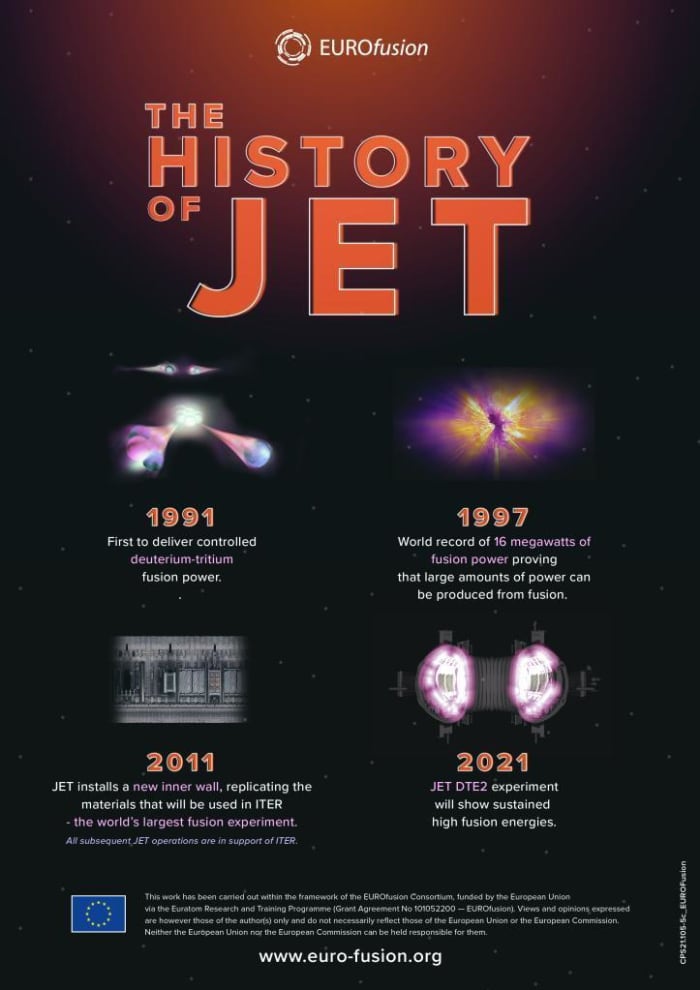It’s the same process that allows the sun and stars to shine blindingly bright and if scalable, could mark a serious contender in an energy mix that takes on climate change.
A large, doughnut-shaped machine known as a tokamak, developed by scientists working in the English village of Culham, near Oxford, generated a record-breaking 59 megajoules of sustained nuclear fusion energy over five seconds during trials in December, the scientists revealed Wednesday. That more than doubles the previous record for generating and sustaining fusion.
Nuclear fusion is the process of fusing two or more atoms into one larger one, a process that unleashes potentially usable energy as heat. Nuclear power used today is created by a different process, called fission, which relies on splitting atoms and harnessing that energy.
A magnetic field is required to contain the high temperatures created by the fusion process — some 150 million degrees Celsius, 10 times hotter than the center of the sun.
Scientists have generated fusion energy before, but sustaining the power has been the sticking point. For now, five seconds is the limit the machine can sustain the power before its magnets overheat, explained Tony Donné, CEO of EUROfusion, which ran the tests, at a press conference.

EUROFusion
“The record, and more importantly the things we’ve learned about fusion under these conditions and how it fully confirms our predictions, show that we are on the right path to a future world of fusion energy. If we can maintain fusion for five seconds, we can do it for five minutes and then five hours as we scale up our operations in future machines,” said Donné.
EUROfusion is a consortium of 4,800 scientists, students and staff from across Europe. The U.K. Atomic Energy Authority was also involved, while the European Commission contributed funding.
“It’s clear we must make significant changes to address the effects of climate change, and fusion offers so much potential,” said Ian Chapman, of the Atomic Energy Authority. “We’re building the knowledge and developing the new technology required to deliver a low-carbon, sustainable source of baseload energy that helps protect the planet for future generations. Our world needs fusion energy.”
Don’t miss: Nuclear, carbon capture, technology jobs: Biden hits on climate-change words Republicans like to hear
Current nuclear energy, while considered by its proponents to be much “cleaner” than alternatives, including oil CL00, +0.41% and gas NG00, -6.07%, creates waste that can remain radioactive for tens of thousands of years.
It’s also potentially hazardous in the event of an accident, such as Japan’s 2011 Fukushima disaster, which followed the area’s deadly earthquake and tsunami. Notable nuclear catastrophes also rocked Chernobyl, in Ukraine in 1986, and Pennsylvania’s Three-Mile Island, in 1979. But plenty of plants have churned out energy without incident.
Related: Good news for uranium: Nuclear energy has a record reliability, despite past disasters
Nuclear energy, presumably using the traditional process, has been tossed into a wide-ranging climate and energy proposal advanced by President Joe Biden. But as part of a broader spending bill known as Build Back Better, climate-change initiatives and other proposals have run into speed bumps in a closely contested Congress, including skepticism from energy-state Democrat Joe Manchin of West Virginia.
Manchin has told Biden it would be easier to pass the $ 500 billion in climate provisions tucked into Build Back Better as a stand-alone bill, and Biden has shown interest in just such a move.
Read: Even a majority on the political right in the U.S. is now sweating climate change, poll finds
Already, the bipartisan infrastructure package enacted last year vowed spending in areas that both Manchin and Biden say they can get behind, including $ 10 billion for carbon capture and $ 2.5 billion for advanced nuclear. Some environmentalists say carbon capture won’t do enough to slow demand for oil and gas, known to accelerate global warming. Manchin has also been an outspoken supporter of clean hydrogen, which remains in early stages; Congress allotted $ 8 billion for hydrogen fuel hubs under the infrastructure bill.
Read: Don’t rule out natural gas in the clean-energy transition, trade group says
Build Back Better includes another $ 23 billion in production tax credits for nuclear, according to the Joint Committee on Taxation.
In a 2020 poll by Morning Consult, 1 in 3 adults thought the U.S. should keep current nuclear plants online but not build any new facilities. Some 16% believed the U.S. should keep existing nuclear plants operational and build new reactors. And, 29% viewed nuclear energy favorably, while 49% viewed it unfavorably, making it the most unpopular energy source other than coal, at that time.
